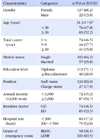Abstract
Purpose
The purpose of this study was to identify the job of emergency room (ER) nurses working in small and medium sized hospitals and to explore factors affecting their job.
Methods
The survey data were collected between January 2014 and May 2014 and participants were 159 nurses working in Seoul, Kyunggi, Incheon, and Chungnam in hospitals of less than 500 beds.
Results
The score for nurses job was 2.12/4.0, and emergency treatment (1.87/4.0) followed basic nursing (3.51/4.0) and counseling (2.32/4.0). The nursing job was significantly different depending on the age, education level, position, resident doctor(emergency medicine specialty or other) and grade of ER (regional ER or local ER). In the multiple regression, education level (β=.18), position (β=.24), hospital size (β=.20), and grade of ER (β=.21) explained 17.0% of variance in ER nurses' job in small and medium sized hospitals.
Conclusion
The findings indicate that ER nurses in vulnerable areas do more nursing practice including emergency treatment as well as the usual independent nursing practice. Accordingly, a systematic assignment of nursing professionals is needed to reduce loading of ER nurses in small and medium sized hospitals.
Figures and Tables
Table 3
Job of Emergency Room Nurses in Small and Medium Sized Hospitals by General Characteristics (N=159)

Table 4
Affecting Factors Emergency Room Nurses' Job in Small and Medium Sized Hospitals (N=159)

*p<.05, ***p<.001; †Dummy variables (Gender 1=male, 0=female, Total career (1) 1=5~9 years, 0=1~4 &≥10 years, Total career (2) 1=≥10 years, 0=1~9 years, Marital status 1=married, 0=single, Education level 1=baccalaureate, 0=diploma, Position 1=≥charge nurse, 0=staff nurse, Annual income 1=≥3,000, 0=<3,000, Resident doctor 1=general or other department doctor, 0=emergency medicine doctor, hospital size 1=300~<500 beds, 0=<300 beds, Grade of emergency room 1=Local emergency medical facilities, 0=Regional emergency medical center).
References
1. Yoon HD, Jung SY, Lee MH, Gang MJ. National emergency medical center. 2012 Statistics of emergency medical system. Seoul: National Emergency Medical Center;2013.
2. Lee YG, Shin HH, Lee JJ. Problems and challenges of national emergency medical system. Korean Institute of Hospital Management;2013. KIHM-130807.
3. Moon JL. Status and future direction of emergency medical services. Paper presented at: The Assembly Policy Seminar. 2012 September 12; Seoul, Korea.
4. Korea Ministry of Government Legislation. Law of medical service [Internet]. Seojong: Korea Ministry of Government Legislation;2015. cited 2015 June 1. Available from: http://www.law.go.kr/%EB%B2%95%EB%A0%B9/%EC%9D%98%EB%A3%8C%EB%B2%95.
5. Korean Nurses Association. Nurse specialist in the past 10 years [Internet]. Seoul: Korean Nurses Association;2012. cited 2015 Accessed Date. Available from: http://webzine.koreanurse.or.kr/Webzine/read_article.php?webzine_id=36&sub_cat_id=403&is_sub_no=635&article_id=885.
6. Cole FL, Ramirez E. Activities and procedures performed by nurse practitioners in emergency care settings. J Emerg Nurs. 2000; 26(5):455–463. DOI: 10.1067/men.2000.110585.
7. Kim MH. Actual condition of caring emergency department nurses working [master's thesis]. Seoul: Hanyang University;2004.
8. Shin HH. Road map development for support of small & medium sized hospitals. Seoul: Korean Institute of Hospital Management;KIHM 2013-04.
9. Kim BJ, Lee EN, Kang KH, Kim SS, Kim SA, Sung YH, et al. A study of job analysis of the emergency room nurse. J Korean Clin Nurs Res. 2006; 12(1):81–95.
10. Lee WS. A study of job performance of emergency nurse practitioner [master's thesis]. Seoul: Yonsei University;2008.
11. Cooper MA, Lindsay GM, Kinn S, Swann IJ. Evaluating emergency nurse practitioner services: A randomized controlled trial. J Korean Clin Nurs Res. 2002; 40(6):721–730. DOI: 10.1046/j.1365-2648.2002.02431.x.
12. Kim JH, Ahn HY, Eom MR, Lee MY. A study of emergency room nurses' burn-out, nursing performance, and professional identity. Korean J Occup Health Nurs. 2010; 19(1):50–59.
13. Ministry of Health & Welfare. 2013-2017 Plan for emergency service [Internet]. Seojong: Ministry of Health & Welfare;cited 2015 June 1. Available from: http://www.mw.go.kr/front_new/al/sal0301vw.jsp?PAR_MENU_ID=04&MENU_ID=0403&CONT_SEQ=281509&page=1.
14. McGee LA, Kaplan L. Factors influencing the decision to use nurse practitioners in the emergency department. J Emerg Nurs. 2007; 33(5):441–446. DOI: 10.1016/j.jen.2006.10.019.
15. Kim JH, Kim MA, Kim MW, Kim KS, Yoo CS, Lee EH. Analysis on advanced practice performance by emergency nurse practitioners. J Korean Data Anal Soc. 2010; 12(2):781–796.




 PDF
PDF ePub
ePub Citation
Citation Print
Print




 XML Download
XML Download